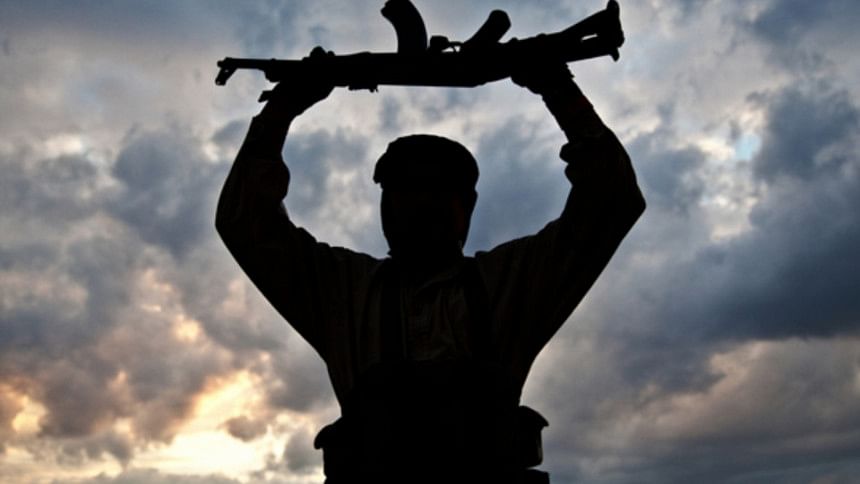Masculinity in crisis and the rise of extremism

People in Dhaka are yet to overcome the shock they experienced after the Gulshan Attack. Detailed reports of autopsy and backgrounds of the assailants are still pouring in. The popular image of militant Islamism has been tarnished after the identities of the assailants were disclosed. The perception that only poor, exploited young men from madrasas turning to militancy as a 'revolt' against the starkly stratified society based on class, is no longer valid. This concept of 'victimhood' does not apply to these young men who came from powerful, wealthy families with prestigious academic backgrounds. Thus, at least for a few of these militants, the question of using Islam as a political tool to revolt against the oppressive class does not apply. None of the assailants claimed to have such political views as well.
A video was released after the attack where three young men praised the Gulshan attack. One of them was identified as a son of an army official. One of the assailants of the Gulshan attack was the son of prominent politician of Bangladesh Awami League. Experts have given their opinions that parents should have a strong bond of love and communication with their children in order to prevent them from embarking on the path of radicalisation. I would like to add that fathers have a crucial role to play in the positive upbringing of their children. The families of the assailants were solvent, where fathers held significant social and political power over the society. It will not be an exaggeration to say that the model of masculinity these young men saw is made of wealth, political power and dominance. Drastically changing status and roles of women in the society is a big threat to this model of masculinity. It demands its ultimate authority even if it is gained through violence. Violence to these misguided people is not only the means of asserting their masculinity, but also exhibiting how a 'real man' should be. This model of masculinity thrives through violence and criminalises everyone who is not like them. This explains why female victims of the Gulshan attack reportedly bore more severe marks of torture by the assailants of the Gulshan attack when compared to the male victims.
The militants' exhibition of violence has had worldwide audience. The image of one of the killers intrigued and shocked people at the same time. It is because according to popular notion, "he looked nothing like a killer". Thanks to the racist and elitist beauty standard of a post-colonial society, he soon gained a female admirer, who claimed to have a 'crush' on him. This model of masculinity successfully gained its legitimacy, not only from radical Islamists who are heterosexual men, but also from a heterosexual woman. It will not be surprising if experts discover that young women fantasise of this violent model of masculinity premised on radical Islam and want to serve as their subordinated counterparts. We can already see signs of it in our society.
Michel Foucault said that the self is the site of multiple practices. Men who exhibit a violent form of masculinity also carry the potential to possess nurturing, care giving qualities. It is this possibility of non-violence and care giving that we should work on to stop radicalisation. Fathers should not only be 'role models' in the sense that they display their power, wealth and dominance. Instead, their model of masculinity should be grounded on the premise of care giving and non-violence. By shifting the core of masculinity in this direction, we can expect future generations of young men to be able to choose the masculinity of non-violence and care giving over the masculinity of violence and power. The upward mobility of women's status and changing role would not be seen as 'threatening to their masculinity' if these young men are taught that real men do not commit violence, real men are pacifiers.
South Asian films have a long history of glamourising sexual violence against women. It is accepted even among the section of the society who does not support Islamist radicalization. Their accepted model of masculinity is also premised on violence. Popular media has historically shown their reluctance in promoting models of masculinity based on care. Care giving, pacifying men are portrayed as effeminate individuals, who are not "real man". It's time that films and literature deconstruct this radicalised, violent model of masculinity and hail the care giving model.
I fully recognise that international politics and economy plays a crucial role in shaping the politics of radical Islam. But this should not exempt us from taking responsibility for Islamist radicalisation at a personal and local level. While the neo-liberal economy integrated a large number of women into different industries, it has also purportedly taken away the sense of power and authority from men who were taught to see the world with a patriarchal view. Without recognising this crisis of masculinity, we will not be able to fully understand the philosophy of religious radicalisation.
As I said before, experts have pointed out what parents should do to stop radicalisation. We must remember that working mothers often have to cope with the double burden of full-time paid work and house work. Even the stay-at-home mothers have the back-breaking responsibilities of repetitive house work and full time child care. If the responsibility of preventing radicalisation falls only upon women, we will only be adding to their miseries. Moreover, it will leave the core of radicalisation untouched. It is high time for men to take responsibility of child care and children's moral education. If men in general fail to recognise the importance of their role as non-violent care givers, we will keep on witnessing many more successful attempts of religious radicalisation of young men in the years to come.
The writer is a freelance photographer.

 For all latest news, follow The Daily Star's Google News channel.
For all latest news, follow The Daily Star's Google News channel. 


Comments